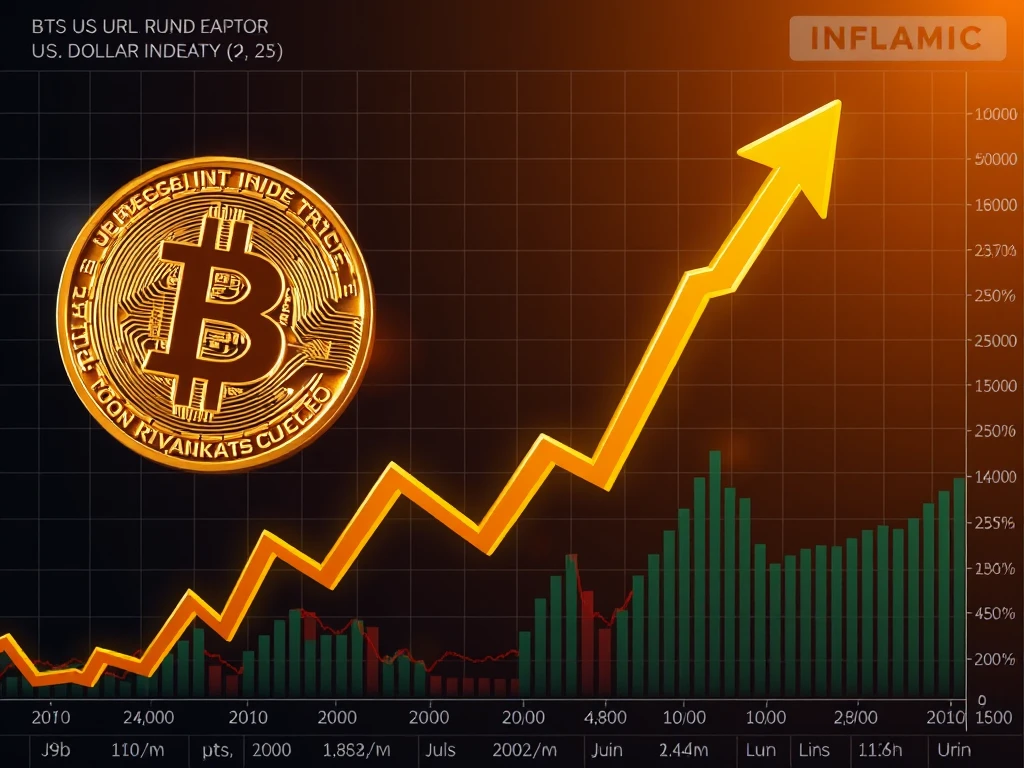Bitcoin Soars to $82K: Dollar Plummets to 3-Year Low Amidst Shocking Inflation Drop

Hold onto your hats, crypto enthusiasts! Bitcoin is showing incredible resilience, maintaining its position above $82,000 even as the US dollar weakens to levels not seen in three years. And that’s not all – the latest Producer Price Index (PPI) data has just dropped, revealing a sharper-than-expected decrease in inflation. Could this be the perfect storm brewing for a continued Bitcoin bull run? Let’s dive into the exciting details.
Bitcoin Price Holds Strong Amidst Dollar Weakness
Bitcoin (BTC) demonstrated remarkable strength as it aimed for higher ground around the Wall Street open on April 11th. This bullish momentum comes on the heels of the latest US inflation data, injecting a fresh dose of optimism into the market. Despite the ongoing tensions of the US trade war, developing bull market signals are providing a robust foundation for Bitcoin prices.
Market data from Crypto News Insights Markets Pro and TradingView confirms this upward trend, with BTC/USD reaching peaks of $83,245. This surge coincided with the release of the US Producer Price Index (PPI) data, which significantly undershot expectations.
PPI Inflation Plunge: A Bullish Signal for Bitcoin?
The latest figures reveal a significant cooling in producer prices. The PPI came in at a mere 2.7% against a predicted 3.3%, while the core PPI print also surprised economists by falling below anticipated levels. The US Bureau of Labor Statistics (BLS) official report highlighted:
“In March, over 70 percent of the decrease in the index for final demand can be traced to prices for final demand goods, which fell 0.9 percent. The index for final demand services declined 0.2 percent.”
This unexpected drop in PPI inflation has sparked considerable reaction across financial markets. The Kobeissi Letter, a respected trading resource, highlighted the dramatic shift, noting:
“We just saw the first month-over-month decline in PPI inflation, down -0.4%, since March 2024. Both CPI and PPI inflation are down SHARPLY.”
To put this into perspective, consider these key points about the PPI data:
- **Significant Undershoot:** The 2.7% PPI is substantially lower than the 3.3% expectation, signaling a more rapid deceleration in inflation than anticipated.
- **Month-over-Month Decline:** The -0.4% month-over-month decrease is the first since March 2024, indicating a potential shift in inflationary trends.
- **Broad Impact:** The decrease is largely attributed to falling prices in final demand goods and services, suggesting a widespread cooling effect.
Market Reaction: Risk Assets and Trade War Dynamics
Interestingly, the broader risk asset market, particularly stocks, didn’t immediately mirror the positive inflation news. The S&P 500 experienced a slight dip of 0.2%, and the Nasdaq Composite remained flat. This muted response comes after a previous day of stock market declines despite positive CPI data. Analysts suggest that these market movements are intertwined with the ongoing US trade war, where positive macro data might inadvertently fuel trade tensions.
Crypto analyst Michaël van de Poppe echoed this sentiment, suggesting that lower PPI data could be seen as beneficial for President Trump’s trade strategy, which heavily relies on tariffs. He stated, “PPI comes in significantly lower. That’s great for Trump and his strategy. The only thing that needs to be resolved is the on-going Trade War, but the ingredients are building up.”
US Dollar Weakness: A Powerful Catalyst for Bitcoin?
Adding another layer to the bullish narrative is the significant weakening of the US dollar. The US Dollar Index (DXY), a measure of the dollar’s strength against a basket of major currencies, has plummeted below the crucial 100 mark. This is the first time the DXY has dipped this low since 2022, marking a 3-year low for the greenback.
Historically, a declining US Dollar Index has acted as a powerful tailwind for Bitcoin. Popular crypto analyst Venturefounder highlighted this correlation, noting: “Traditionally, DXY going down is very bullish for $BTC. We now have a massive bearish divergence for DXY, which may suggest it goes to 90.”
Venturefounder further elaborated on the historical implications, adding, “Last 2 times this happened triggered a Bitcoin parabolic bullrun in final phase of the bullmarket (lasting 12 months).”
Analyzing the Relative Strength Index (RSI) data for the DXY monthly chart further reinforces this potential trend. The RSI is currently retesting a downward-sloping trend line as support from above, suggesting continued dollar weakness could be on the horizon.
What Does This Mean for Bitcoin and Crypto Markets?
The confluence of factors – falling PPI inflation, a weakening US dollar, and historical patterns – paints a potentially very bullish picture for Bitcoin. Here’s a quick breakdown of why these developments are significant:
- **Inflation Relief:** Lower PPI and CPI data can ease concerns about aggressive monetary tightening by the Federal Reserve, potentially making risk assets like Bitcoin more attractive.
- **Dollar as a Catalyst:** A weaker US dollar often leads investors to seek alternative stores of value, and Bitcoin is increasingly viewed as a prime candidate.
- **Historical Precedent:** Past instances of DXY reaching multi-year lows have preceded significant Bitcoin bull runs, suggesting history might be repeating itself.
However, it’s crucial to remember that the market is dynamic and influenced by numerous factors, including geopolitical events and regulatory developments. While the current signals are promising, thorough research and caution are always advised in the volatile world of cryptocurrency investment.
Disclaimer: This article is for informational purposes only and does not constitute investment advice. Trading and investing in cryptocurrencies involves substantial risk. Always conduct your own research and consider consulting with a financial advisor before making any investment decisions.









